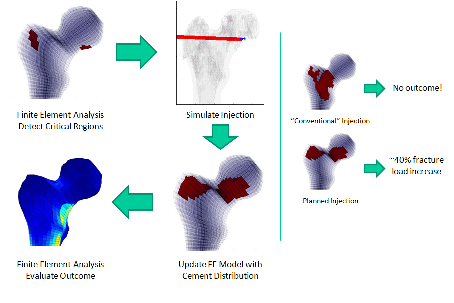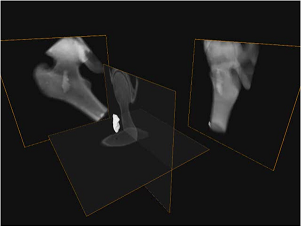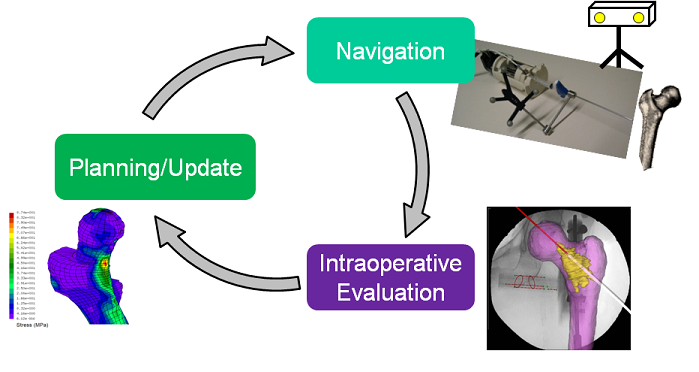Table of Contents
Osteoporotic Bone Augmentation
Our goal is to develop a software workstation to assist in performing femoral augmentation for osteoporotic patients. The surgical procedure consists of a series of bone cement injections into the femur. The bone augmentation system features preoperative biomechanical planning to determine the most advantageous cement injection site(s) and injection protocol to increase the strength of the femur. During the surgery, we will navigate the injection device and inraoperatively reconstruct virtual models of the injected cement. The injected cement models can be used to update the injection protocol intraoperatively.
Approach
This image guided percutaneous femoroplasty system can be divided into three main phases:
- Planning
- Navigation
- Intraoperative Evaluation
Status and Results to Date
For preoperative evaluation we conduct finite element analysis of the biomechanics of the femur from CT image sets.For intraoperative evaluation we are reconstructing 3D model of the bone cement from 2D X-ray projections. During intraoperative evaluation we optimize registration estimates with multi-image optimization



Future Plans
Project Personnel
| Name | Institution | Affiliation |
|---|---|---|
| Dr. Mehran Armand | Applied Physics Lab | Principal Investigator |
| Dr. Russell Taylor | Johns Hopkins University | Principal Investigator |
| Dr. Peter Kazanzides | Johns Hopkins University | Principal Investigator |
| Dr. Yoshito Otake | Johns Hopkins University | Post-Doc |
| Michael Kutzer | Applied Physics Lab | Research Scientist |
| Robert Armiger | Applied Physics Lab | Research Scientist |
| Ryan Murphy | Applied Physics Lab | Research Scientist |
| Ehsan Basafa | Johns Hopkins University | Graduate student |
| Blake Lucas | Johns Hopkins University | Graduate student |
| Ben Xin Kang | University of Hong Kong | Graduate student |
| Wen P. Liu | Johns Hopkins University | Graduate student |
Funding
* NIH
* ERC/LCSR
Affiliated labs
Publications
- E. Basafa, R. J. Murphy, M. D. M. Kutzer, Y. Otake, M. Armand, A Particle Model for Prediction of Cement Infiltration of Cancellous Bone in Osteoporotic Bone Augmentation. PLoS ONE 8(6): e67958. 2013. doi:10.1371/journal.pone.0067958.
- E. Basafa, R. J. Murphy, M. D. Kutzer, Y. Otake, M. Armand, Computer assisted femoral augmentation – modeling and experimental validation, Proceedings of the ASME 2013 International Design Engineering Technical Conferences & Computers and Information in Engineering Conference (IDETC/CIE) 2013.
- E. Basafa, R.S. Armiger, M.D. Kutzer, S.M. Belkoff, S. Mears, M. Armand, Patient-specific finite element modeling for femoral bone augmentation Med. Eng. Phys., http://dx.doi.org/10.1016/j.medengphy.2013.01.003, Feb 2013
- M.D.M Kutzer, E. Basafa, Y. Otake, and M. Armand, An Automatic Injection Device for Precise Cement Delivery During Osteoporotic Bone Augmentation, in Proceedings of the ASME 2011 International Design Engineering Technical Conferences & Computers and Information in Engineering Conference (IDETC/CIE 2011), Aug. 2011.
- X. Kang, R. H. Taylor, M. Armand, Y. Otake, W. P. Yau, P. Y. S. Cheung and Y. Hu, “Correspondenceless 3D-2D registration based on expectation conditional maximization”, Proc. SPIE 7964, 79642Z (2011). [DOI] (Cum Laude Best Poster Award)
- Wen P. Liu, Mehran Armand, Yoshito Otake and Russell H. Taylor, “Optimization of multi-image pose recovery of fluoroscope tracking (FTRAC) fiducial in an image-guided femoroplasty system”, Proc. SPIE 7964, 79641D (2011). [DOI]
- Otake Y, Armand M, Sadowsky O, Armiger RS, Kutzer MD, Mears SC, et al. , “An image-guided femoroplasty system: development and initial cadaver studies,” Proc. SPIE March 4, 2010 7625(1), 76250P (2010).
- Otake Y, Armand M, Sadowsky O, Armiger R, Kazanzides P, Taylor R. , “An Iterative Framework for Improving the Accuracy of Intraoperative Intensity-Based 2D/3D Registration for Image-Guided Orthopedic Surgery,” Lecture Notes in Computer Science 6135, 23-33 (2010).
- Otake Y, Armand M, Sadowsky O, Kutzer DM, Armiger RS, Basafa E, et al. , “Development of a navigation system for femoral augmentation using an intraoperatie C-arm reconstruction,” Proceedings of 9th Annual Meeting of CAOS-International, Boston, June, 177-180 (2009).
- B. C. Lucas, Y. Otake, M. Armand, and R. H. Taylor, “A Multi-view Active Contour Method for Bone Cement Segmentation in C-Arm X-Ray Images”, in Information Processing in Computer-Assisted Surgery (IPCAI), Berlin, June 22-23, 2011.
